US Department of Transportation
FHWA PlanWorks: Better Planning, Better Projects
| Other |
|---|
Idaho’s Transportation Vision
An Inclusive Process Brings Together
Stakeholders to Create a Shared Vision
Executive Summary
In late 2000, the Idaho Transportation Department teamed with stakeholders across Idaho to determine the state’s long-term transportation needs in light of projected demographic changes. Over the course of the next few years, the Department engaged hundreds of people in a joint effort to develop a vision statement for the state’s future transportation system. This visioning process was unique in its approach and has since become a model of collaborative decision making.
The Department began its visioning process with an internal symposium to discuss possible approaches to use. The Department then met with its own planning staff, district managers, and executive leadership to receive their input. Next, the Department conducted a statewide random telephone survey to provide focus points for regional and statewide workshops for invited transportation stakeholders. At these workshops, the Department used town hall polling, mapping, and dynamic, real-time scenario planning of alternative investment patterns to help participants visualize the different possibilities for Idaho’s future. Finally, the Department communicated the results of its public outreach efforts in a comprehensible and inclusive manner.
This approach was ground-breaking in the extent to which it encouraged dialogue among numerous stakeholders, including members of academia, representatives from different levels of government and resource agencies, and the general public. Together, these groups developed a vision of how the Idaho transportation system should look 30 years into the future, creating a foundation for the Department’s long-range planning efforts that would be accessible to all Idahoans and flexible in its implementation. The Department has since incorporated the lessons learned and principles developed through the visioning process into other projects at the Department. The Department’s progressive strategy for bringing together large numbers of stakeholders is an example of collaborative decision making for future transportation planning initiatives beyond Idaho.
Background
Idaho’s transportation system is comprised of a statewide network of more than 60,000 miles of road, 4,000 bridges, 1,900 miles of rail lines, 125 public airports, and the Port of Lewiston.
Project Overview
In 2004, the Idaho Transportation Department (ITD), with assistance from a wide range of stakeholders, completed an intense multi-year effort to develop a comprehensive transportation vision for the state: Idaho’s Transportation Future: Getting There Together. ITD initiated an extensive dialogue and strategy process to create the Vision, engaging hundreds of people from children to politicians to create a shared vision of Idaho’s future transportation system. The Vision defined Idaho’s preferred transportation system of the future, spanning all highway, public transportation, bicycle, pedestrian, water, air, information technology, and rail systems.
Project Motivation
The inspiration for ITD to create a long-term transportation vision was threefold: first, to anticipate how changes in technology would affect Idaho’s transportation needs; second, to update Idaho’s existing transportation infrastructure; and third to, prepare for projected demographic shifts in Idaho’s population.
First, ITD recognized that rapid technological advances would continue into the coming decades. For instance, ITD noted that information technology would play an increasingly important role in Idaho’s transportation future. The commute hours and trip times of tomorrow, though impossible to predict today, could at least be imagined. ITD realized that Idaho’s transportation system would need to accommodate these changes and technological advances if the system is to continue to function smoothly.
Second, the state’s transportation system was aging, and in many places had become inadequate for Idaho’s needs. For example, many of Idaho’s bridges were built in the 1950s and early 1960s during the interstate construction era. To maintain their viability, these bridges would require an infusion of funds for maintenance, rehabilitation, reconstruction, and eventual replacement. Further, while most people ITD surveyed stated they were generally satisfied with the current highway-focused transportation system, many worried that increasing congestion, competition for funding, and limited additional road networks would likely occur in the future.
ITD also assessed Idaho demographics and projected growth for the state. Idaho has experienced tremendous growth over the past 30 years and today is the nation’s third-fastest growing state. In that time, its population has risen by more than 50 percent. The number of registered cars in Idaho has nearly doubled and the number of vehicle miles traveled has more than doubled (see Figure 1).
Figure 1. Idaho Growth in Various Metrics, 1978 to 2004

Current projections show this trend continuing. Idaho’s population is projected to increase 58 percent between the years 2000 and 2030. This growth will result in numerous challengesnot the least of which is how Idaho will accommodate this future growth while at the same time preserving the state’s quality of life, natural resources, and economic prosperity.
These challenges were exacerbated by the fact that Idaho’s transportation revenue was not keeping pace with the state’s growth. Although most states supplement transportation fees with income from sales taxes, general funds, and local option taxes, Idaho does not. ITD funding comes primarily from three sources: the federal fuel tax, the state fuel tax, and vehicle and truck registration fees. In anticipation of more fuel-efficient vehicles hitting the road and the escalating costs for highway material costs, ITD predicted a widening gap between available revenue and transportation needs.
ITD decided on a proactive approach to assure the public that the state’s transportation system would be able to meet the coming demands on limited resources. While federal planning regulations required the Department to look at a minimum 25-year timeframe as part of its long-range planning process, ITD extended the Vision to 30 years. According to ITD leadership, the Department “wanted to capture a longer timeframe to show that really revolutionary changes were coming by 2034. If you look back through transportation history for major changes, it seems to occur in such 30 to 40 year time increments.” The agency wanted to keep the conversation with stakeholders at a visionary level, encouraging participants to step out of their current roles and mindsets and to think “outside-the-box.”
Prior to this 30-year visioning process, ITD attempted, and ultimately aborted, a proposed transportation strategy with little public involvement. The ITD Board rejected the plan because there was no sense of public commitment to the strategy. Transportation stakeholders, including members of the general public and ITD staff, voiced frustration with disjointed decision making and with the lack of integration of land use management.
The Department’s Director, who was dissatisfied with the development of the Department’s long-range plans, saw the need for an action-oriented document to help guide future development. This “vision” document would determine what the public wanted in future transportation solutions. The Director clarified that he did not want another long-range plan with a specific roadmap of projects; rather, he wanted a concise vision document (15 pages maximum) to be developed with widespread public involvement. To encourage broader thinking, the Vision was to be developed without political or economic restraints.
Institutional Framework for Decision Making
The process of developing the Vision involved several key groups of decision makers. First, these included the ITD Director, department staff, and the Idaho Transportation Board. ITD’s Director initiated the visioning process and set the course for the department. Key staff members, particularly the project management team, followed his lead and instigated a “culture change” at the department. The department, with support from the Idaho Transportation Board, changed from an organization that rarely appreciated collaborative decision making to one with a “team-based culture.” The Board provided the executive leadership and support throughout the visioning process that became essential to this project’s success.
Another key group was the consultant team, led by the firm CH2M Hill. ITD hired CH2M Hill to design, develop, and create a long-range transportation vision. CH2M Hill was joined on the consultant team by a diverse group of sub-consultants with particular expertise in research, future technology, transportation planning, and stakeholder engagement. Though ITD managed the consultant team and was ultimately responsible for bringing together the various stakeholders, including the resource agencies, metropolitan planning organizations (MPOs), tribes, and the public, ITD relied heavily on its consultants and the experience they brought to the decision making process.
In addition to these decision makers, ITD formed two additional ones. ITD created the Vision Management Team (VMT) and the Executive Roundtable (ERT) to share technical and policy expertise, providing key approval authority throughout the visioning process. The committees included not only transportation planners, modal experts, and operational managers, but also business leaders, policymakers, and special interest groups.
The VMT provided technical expertise with a membership that included senior transportation planners from the administrative districts, senior officials from the public transportation division, rail and freight senior transportation planners, a bicycle/pedestrian planner, a services manager from the Department of Motor Vehicles, an aeronautics planner, a district engineer, a member of the public affairs group, and a professional facilitator.
To complement the VMT’s technical perspective, the ERT contributed policy expertise to the visioning process. The ERT was comprised of 12 to 15 external stakeholders who represented universities, multinational corporations, private transit providers, the Idaho National Engineering Laboratory, bicycle/pedestrian advocates, the Department of Commerce, the Governor’s office, and the Idaho Cities Organization and Local Technical Assistance Council, which represents highway districts through Idaho.
The value of these two committees’ extended beyond acting as additional groups of decision makers. Due to their diversity, these committees represented the communities ITD hoped to engage. Moreover, they helped to engage people in the decision making process that otherwise might have been overlooked. The result was a more inclusive visioning process.
The way the process was set up emphasized inclusion. Stakeholders got lists of community leaders from their respective communities and also picked a broad cross section within the community to participate in the workshops” – Project Manager
Community Involvement and Input
Stakeholder organizations and the public were extensively involved in several stages of the visioning process. ITD held workshops throughout the process that brought together all of the MPOs and land use decision makers, along with nonprofit organizations and environmental non-governmental organizations. The VMT worked with the consultant team to create contacts for a stakeholder database. By mid-February 2003, the stakeholder database included more than 2,500 organizations and individuals.
ITD conducted a statewide survey in the Research and Development phase of the project to inform the Project Team and its advisors about the public’s current perceptions regarding transportation. ITD then developed a visioning video for use in six regional workshops across the state. The workshops were intended to provide a forum for the ITD to share the results of the public survey, to provide an increased understanding of the demographic data, and prioritize issues in each region. Invitations to the workshops were sent to organizations and individuals in the stakeholder database.
Transportation Decision making Process
Overview of Process
The process of developing the Vision involved a wide range of activities undertaken from 2000 to 2004. Figure 2 (next page) identifies the key steps in this process. ITD conducted the first three steps of the process, and the consulting team designed and conducted the remaining activities, from the Golden Thread Workshop through to endorsement. The consultant team drew on innovative techniques and technologies to help facilitate development of the Vision.
Transportation Symposium
A vision is a widely supported statement describing the values held within a community, region, or state, and how these values should be reflected in the transportation system and development patterns. It is meant to evoke thoughts about the nature of future transportation systems, realizing that decisions made today affect short- and long-range development.
In August 2000, ITD began to develop the Vision by sponsoring a symposium titled, “The Coming World of Transportation” that brought together over 200 participants, including members of the Idaho Transportation Board, ITD executives and mid-managers, and other transportation stakeholders.
Experts on future trends (“futurists”), subject matter experts, and other transportation professionals presented information about the future of transportation and its expected impact for Idaho. In addition, the group discussed challenges and opportunities associated with urbanization and growth for transportation management.
Participants were asked to share their concerns and opinions, which were used to help shape the visioning process. By the end of the symposium, participants expressed the following elements they would like to see in a transportation vision:
- The Vision should be understood and shared across the state and with other stakeholders;
- A vision process should incorporate forecasting activities;
- Technology should be embraced and used effectively and efficiently;
- ITD should be structured and staffed to manage new challenges;
- ITD should build on its relationships with the public, MPOs, and elected officials at the local, state, and federal levels;
- A flexible, proactive, and innovative approach to work and risk taking should be supported in the future; and
- ITD should pursue planning funds, innovative ways for generating revenues, and address challenges associated with the distribution of funds.
Initial Meetings between ITD Planners and Districts
During June and July of 2001, ITD planners met with key district staff and, in many cases, key transportation stakeholders. The goal of these district meetings was to discuss the purpose of a long-range transportation vision, to understand the vision’s role with respect to other ITD planning documents, and to obtain key input for creating a useful visioning document.
Figure 2. Steps in the Development of Idaho’s Transportation Vision
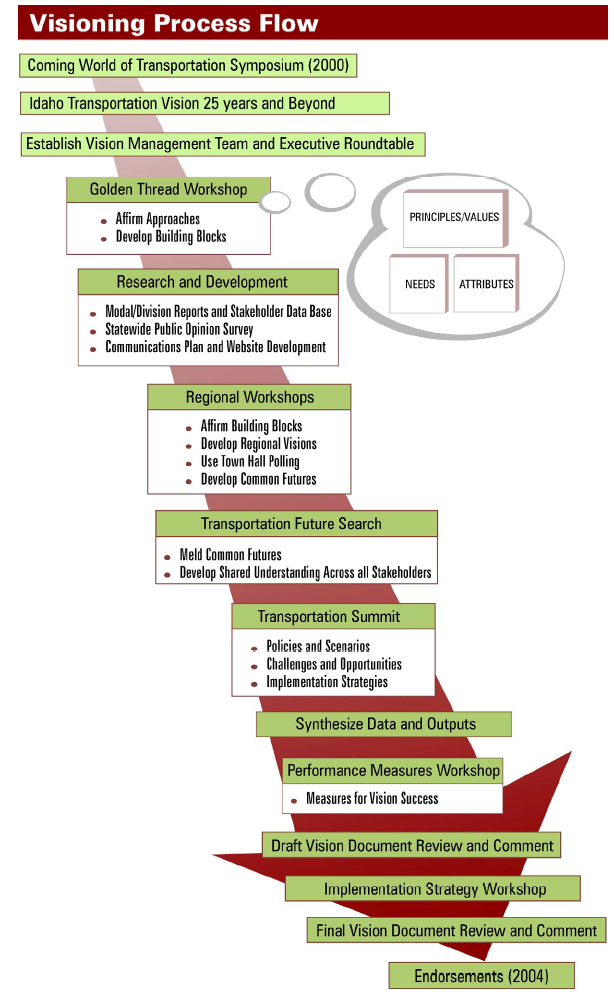
Based on these meetings, ITD compiled a report titled “Idaho’s Integrated Transportation Vision” and presented recommendations to the Idaho Transportation Board. The report was a formulation of the stakeholders’ input into what kind of process and resulting document would best serve ITD and its stakeholders to guide long-range transportation planning in the state. The report called for an integrated transportation vision instead of a long-range transportation plan.
The report made clear that the Vision document, as a guide to the integration of Idaho’s transportation system for internal and external audiences, should:
- Articulate an unconstrained vision for the state’s transportation system for the next 25 years and beyond;
- Outline ITD’s principles and values that guide and direct, enable decision making, and collectively lead to an integrated transportation system;
- Be a driving document and decision making resource to plans that support it (corridor, strategic, district, modes, etc.);
- Unify and integrate various plans;
- Integrate modes;
- Stimulate coordinated decision making; and
- Be subject to a development process reflecting ITD leadership, stakeholder involvement, and statewide public involvement.
The Board approved the report at its September 2001 meeting and gave the formal go-ahead for ITD to continue the visioning process. This formal approval represents a key decision point and set the direction for a broad, inclusive, and innovative visioning project.
Developing a Structure for the Development of the Vision
“Buyoff at the highest level was crucial, by someone who can take on the challenge and not just the risk” – ITD Planner
At the outset of the visioning project, ITD leaders knew that the agency did not have sufficient staff or experience with collaborative decision making processes and technologies to support the visioning process internally. In June 2002, ITD hired CH2M Hill to design a long-range transportation vision. This consultant team included a number of diverse sub-consultants, including Envision, with expertise in research, future technology, transportation planning, and stakeholder engagement to design, develop, and execute the process.
Figure 3. Guiding Principles
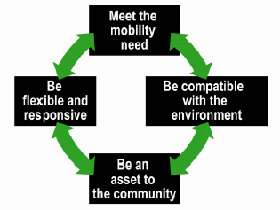
Another important step in the process was the development of two key groups to provide leadership in the development of the vision, as described earlier – the Vision Management Team (VMT) and the Executive Roundtable (ERT).
The VMT researched the background and potential challenges for developing a Vision and designed an approach to identify and gain buy-in from stakeholders. The ERT provided more of a policy perspective compared to the VMT’s technical background.
Golden Thread Workshop
In November 2002, the VMT, ERT, and the Idaho Transportation Board met at what was called the “Golden Thread Workshop.” The purpose of this workshop was to develop the guiding principles for a unified visioning process and to determine the planning horizon. At the Workshop, the participants agreed on the 30-year window as their planning horizon (to the year 2034) and spelled out the principles that would guide the process for developing the Vision (see Figure 3).
As the teams saw it, the principles of the Vision were not directed solely toward efforts to increase mobility; instead, they would also consider the community benefit as well as ITD’s environmental steward role.
The participants identified four key principles:
- The principle of Mobility Need addresses the issue of effectiveness of the transportation system from both a financial and user perspective. The financial perspective speaks to affordability, while the user need becomes the particular area of focus;
- The commitment to Compatibility with the Environment affirms that Idaho has a history that is strongly associated with its natural resources. The Idahoan theme of respect and value for the natural environment continues today and into the future;
- The commitment to Community Assets affirms that each community is responsible for defining itself and what constitutes success for its transportation system. Idaho’s existing transportation infrastructure is a unique asset that will require continued operation, maintenance, and modification to serve future system needs. Modification and/or expansion to address system needs must be done within the scale and context of the community to maintain the asset value; and
- Flexibility and responsiveness recognizes that many new needs, ideas, opportunities, and realities will arise over the next 30 years. Constant and committed efforts must be taken toward Idaho’s Vision of a fully balanced transportation system. This means that the Vision must be open to options, opportunities, and community input as time passes.
Research and Development
From November 2002 to February 2003, the Project Team (including ITD, VMT, ERT, and the consultant team), developed resource and reference materials, background information, and educational instruments as part of the Research and Development phase of the visioning process. The Project Team created a website with modal reports, demographic information, and a process schedule. The Project Team also conducted a statewide survey to identify the public’s perceptions about transportation. The survey’s results were subsequently used as a baseline for public understanding of transportation issues, demographic trends, and travel habits.
The VMT worked with CH2M Hill to create a stakeholder invitation database, and, by mid-February 2003, more than 2,500 organizations and individuals populated the list. The database included contacts generated by the VMT, ERT, and agency contacts. The process was very conscious of the needs and input of stakeholder groups and proactive in obtaining representation across these groups.
ITD staff developed a Visioning Video with input from the project’s futurist. It was designed to show how future transportation would look and feel, while highlighting the trends and changes coming in Idaho’s future. The video helped stakeholders think creatively and positively about their long-range views and concerns for transportation in the state.
Regional Workshops
ITD divided Idaho into six regional districts based on existing state administrative boundaries (see Figure 4) and held workshops in each in March and April of 2003. The workshops gave the public an opportunity to learn about attitudes and perceptions on transportation in their region and helped create an understanding of demographic trends, technological opportunities, and mobility issues 30 years into the future. Finally, the workshops helped to develop a set of priorities for each district.
Figure 4. Six Regional Districts used in Workshops
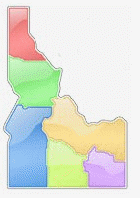
In addition to showing the Visioning Video, regional workshops featured innovative town hall electronic polling in which workshop participants voted anonymously using handheld remotes while the results were displayed in real time.
In the workshops, stakeholders identified several of the public’s major transportation concerns. One of the public’s greatest frustrations was the apparent disconnect between transportation planning and land use planning. For example, stakeholders explained that future planning efforts should take into consideration that local roads are used both by farmers transporting their produce to market as well as nearby residents taking their children to school safely.
The dichotomy of rural and urban land uses and related transportation needs were constant themes in the workshops. Because Idaho is growing and changing rapidly, rural areas are urbanizing, resulting in sometimes incompatible land uses. As a result, stakeholders spoke to the need for changes in transportation facility design, access, and modal applications. Also, Idahoans were concerned that alternative forms of transportation, such as bicycling or walking, were seldom considered. In general, stakeholders asserted that transportation and urban planning processes were not considered jointly.
Some of the other major concerns that emerged at these workshops included the following:
- Connectivity issues between urban and rural communities;
- Access to other states and Canada is inadequate and presents challenges to freight and air mobility and economic development;
- Lack of coordinated planning with communities based on models that could allow better land use choices (and less transportation);
- Highway and driver-focused transportation system has created a number of impacts, including limited bicycle path connectivity, access to public transportation, and isolated neighborhoods;
- Lack of public awareness about transportation issues;
- Inadequate access and focus on the disabled and the elderly;
- Corridor preservation and right-of-way acquisition are not “future”-focused and often difficult to accomplish;
- Safety issues including a lack of turn-outs or shoulders for emergency use; and
- Inadequate funding to support necessary improvements to infrastructure and lack of flexibility to create a more diverse system.
Teams of seven to eight people identified approaches to address major issues identified by the polling process. Workshop participants were informed that there would be a statewide conference where delegates from each region would create a unified Vision. Participants and non-attendees were able to view the results of each workshop on a public website.
Transportation Future Search
The statewide “Future Search Workshop” was held in May 2003. Approximately 70 stakeholders, drawn from the diverse representation at the regional workshops across Idaho, participated in the two-and-a-half-day process to help assess vision(s) for Idaho’s transportation system over the next 30 years. Back-casting exercises, in which participants were asked to look “back” from a point in time in the future, facilitated the process and developed common themes and characteristics of a future transportation system.
O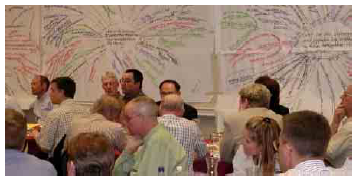 ne of the exercises was a brainstorming activity to identify as many unprecedented world-transforming innovations as possible in a 20-minute period. Another activity engaged teams to focus on the future by looking at it from the perspective of the past. Teams representing the Idaho Archives Commission imagined that they were in the year 2033, and looked back to document the key events, trends, and intervening factors they imagined had occurred over the past 30 years, from 2003 to 2033.
ne of the exercises was a brainstorming activity to identify as many unprecedented world-transforming innovations as possible in a 20-minute period. Another activity engaged teams to focus on the future by looking at it from the perspective of the past. Teams representing the Idaho Archives Commission imagined that they were in the year 2033, and looked back to document the key events, trends, and intervening factors they imagined had occurred over the past 30 years, from 2003 to 2033.
The Future Search Workshop also called for regions to work together to develop a “best case” scenario for the following bi-regional areas: North Idaho, Southwest Idaho, and Southeast Idaho. The workshops used bi-regional areas to help participants think beyond their normal boundaries because air shed and environmental impacts do not stop at administrative boundary lines.
Each of these bi-regional teams developed statements and transportation system maps for their preferred future. In addition, they submitted the assumptions and specific inter-modal connections they needed to achieve their preferred future.
T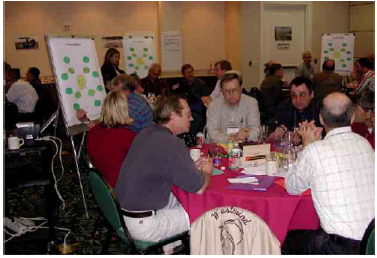 he workshop also identified gaps between the related/preferred future scenarios identified and procedural, socio-economic, modal, and political realities. Following the Future Search Workshop, all participants and mailing list members received a newsletter update.
he workshop also identified gaps between the related/preferred future scenarios identified and procedural, socio-economic, modal, and political realities. Following the Future Search Workshop, all participants and mailing list members received a newsletter update.
Transportation Summit
In July 2003, approximately 20 stakeholders met at the Transportation Summit to create an initial policy framework for the Future Search Workshop’s envisioned transportation system. The team created and evaluated alternative scenarios based on the values and priorities stakeholders had submitted from individual wireless keypads in workshops. Once again, town hall styled polling gathered the inputs, which created critical success factors by identifying key policy choices that would have to be made for the Vision to be realized. The process involved the following steps:
- Participants were polled to determine their priorities and values.
- Participants reviewed a 30-year current trend scenario for the region and scored its performance based on the priorities expressed in step one. A computer model forecasted the impacts of policies decades into the future and allowed participants to witness the impacts of future scenarios presented through a series of map animations, graphs of over 100 performance indicators, images, and other visualizations. The model provided outputs covering a wide range of issues including transportation (congestion, safety, vehicle miles traveled, modal split, travel times, etc.), land use, air quality, infrastructure costs, taxation, greenhouse gas emissions, ecological preservation, waste, water, energy, housing demographics, and economic growth.
- Using the wireless keypads, participants voted on options in a wide range of policy and investment areas including transportation, land use, housing, environmental management, and economic development. Transportation options included highway and transit infrastructure development options, transportation demand management policies, and the development of cycling and pedestrian modes. Facilitators helped participants create and evaluate alternative scenarios. Scenarios were compared side-by-side with current trend scenarios and were evaluated against the values and priorities expressed in step one.
- Workshop facilitators worked iteratively with the participants until a desired future scenario was created. In the process of arriving at a shared vision, many different on-the-fly scenarios were evaluated.
- Based on the desired future scenario, or vision, that was created, participants discussed the priority policies and programs that would be needed in future years to begin working towards the 30-year vision. Participants discussed tradeoffs implied by the preferred scenario and ways that these tradeoffs can be best mitigated.
Scenario planning provided insight into the connections among policy implementation, needs, and priorities across a wide range of issues. To assist in the creation of the Vision, ITD used an interactive regional scenario analysis software, called MetroQuest, to create and evaluate alternative scenarios in real-time based on input from stakeholders.
MetroQuest was developed as a joint effort between the University of British Columbia’s Sustainable Development Research Institute and Envision Sustainability Tools, a private company based in Vancouver, British Columbia. Stakeholders used MetroQuest to explore and understand in a workshop setting the synergies between economic development and land use, transportation, housing, and environmental management.
Key to the success of this technique was MetroQuest’s ability to create on-the-fly scenarios in the workshop. Participants were able to quickly play-out and score alternatives on a wide range of priority areas, including transportation (congestion, safety, vehicle miles traveled, modal split, travel times, etc.), land use, air quality, infrastructure costs, taxation, greenhouse gas emissions, ecological preservation, waste, water, energy, housing demographics, and economic growth. In an iterative process, participants honed in on a preferred scenario that best met their collective priorities. The result was a long-range vision for transportation that was informed by land use and other associated plans.
The Summit resulted in a preferred vision that was used to form the basis for the development of performance measures and for the refinement of the vision during the next steps in the process.
Project leaders and participants reported that pairing wireless keypads for town hall polling and MetroQuest contributed significantly to the success of the visioning process. Together, these technologies allowed participants to:
- Register their values and priorities anonymously
- Visualize the outcome of collaborative scenario choices instantly
- Score alternatives against their own priorities
- Work together to develop a vision that is “theirs”
An ITD representative leading the process stated:
I can’t imagine the process having gone even 50 percent of where it went without those tools. There were a lot of tools that were used: town hall polling allowed people to be citizens, to vote differently and anonymously. Scenario planning allows you to have insight and make connections between policy implementation, needs, priorities, from as wide an array of issues as you could ever imagine. In addition to getting buy-in from people during the process, scenario planning helped the public learn that we were seeking a different set of outcomes and we wanted them to provide us those outcomes because they were the people we served. It would have been impossible without some kind of dynamic program. In addition to holding their attention and keeping them at meetings, they were invaluable in terms of ability to bring knowledge, experience, and wisdom out of people into a document.
Following the session, summit participants broke into four teams reflecting the top-level priorities synthesized from past stakeholder work and research. The teams developed accountability matrices through a planning tool called RACI, which stands for Responsible to lead, Approval authority, Coordinated with (whom), and Informed (who must be informed).
These RACI matrices identified the actions that were needed to be taken, identified who would coordinate and improve them, and addressed resources that were necessary to realize these priorities. The Project Team developed a first draft of the Vision based on input from previous workshops, meetings, and the Transportation Summits. This draft Vision was used in preparation for the Performance Measures Workshop.
Performance Measures Workshop
The Idaho Legislature requires ITD to have output-based performance measures (see box, next page) to improve agency performance and strengthen accountability.
For the visioning process, the Performance Measures Workshop was held in September 2003 for defining more responsive management actions. Participants included the VMT, ERT, and representatives from the regional and statewide workshops. The overall intent of this workshop was to introduce performance measures into the visioning process. Since the use of performance measures was novel, participants focused on specific ways in which performance measurement was useful to the Vision.
- Number of highway projects ready to bid on time
- Number of projects awarded within programmed amounts
- Percent of pavement in fair or better condition
- Number of restricted bridges
- Number of highway fatalities
- Percent of seat belt usage
- Number of improved railroad crossings
- Number of eligible aircraft registered
Workshop participants refined the performance measures that the Project Team initially drafted. Participants built on the existing measures and defined mechanisms for assuring the measures were used.
They developed a list of barriers to successful implementation as well as suggestions for overcoming these obstacles. The performance measures linked strategic intent with follow-up action, created a more responsive management, and demonstrated accountability to stakeholders.
Implementation Strategy Workshop
In November 2003, the Implementation Strategy Workshop was held with the ERT. The workshop addressed specific strategies for obtaining stakeholder buy-in, commitment, and maintaining momentum. The Project Team agreed on next steps, developed an implementation approach, and set a schedule for completion of the Vision document.
Completion of the Vision Process
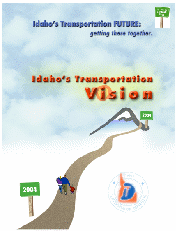 By the end of March 2004, ITD completed the final version of the Vision. The Idaho Transportation Board adopted the Vision after Idaho’s Transportation Partners, including four external ERT representatives, made a formal presentation to the Board. True to its intent, the Vision stated simply:
By the end of March 2004, ITD completed the final version of the Vision. The Idaho Transportation Board adopted the Vision after Idaho’s Transportation Partners, including four external ERT representatives, made a formal presentation to the Board. True to its intent, the Vision stated simply:
The citizens of Idaho aspire to have a transportation system that provides convenient access throughout the state and region. They want different means of transport to support the vitality of the state’s economy, an abundance of family-wage jobs, and ‘the Idaho way of life.’ They recognize the need for the efficient flow of freight and other ‘through traffic’ along highways and between airports. They appreciate the ability to slow down to enjoy recreational opportunities afforded by Idaho’s natural beauty. Across every region, they desire well-connected pedestrian and bicycle facilities so they do not always have to move in vehicles.
Idaho’s Transportation Vision raised public awareness about the impacts of short-term transportation planning actions over the long-term. Today, the IDT regularly references the Vision during its planning process.
Outcomes of the Vision Process
The 30-year vision that was created in Idaho has gone on to affect a wide range of other planning activities throughout the state, including the following: focal plans, including one for aeronautics; MPO long-range planning; multi-county regional planning efforts (for land use and transportation planning); and, Grant Anticipated Revenue Vehicle (GARVEE) Bond decisions.
More generally, ITD representatives reported that the project’s most important legacies might be the Department’s improved relationship with stakeholders and the Department’s ability to make decisions with increased confidence.
Since completing the Vision, ITD has used the document to complete a wide range of projects. Planning decisions use the process developed during the visioning effort to better coordinate look and feel across disparate planning processes within ITD and among its partners.
Airstrip Network Action Plan
In June 2005, ITD relied on the Vision to complete its Idaho Airstrip Network Action Plan. The plan discussed the future of Idaho’s recreational airstrips, small aviation facilities located in the backcountry and in rural and wilderness areas.
The Action Plan outlined strategies to guide backcountry airport use, management, maintenance, and improvement. ITD followed the Vision’s inclusive approach to gathering interested stakeholders – in this case, transportation officials, pilots, forest managers, outfitters, and others – in a series of regional workshops to discuss stakeholder preferences for the airstrip system’s configuration in 2034.
Since the Board’s adoption of the airstrip Action Plan, ITD has formed two subcommittees to oversee its implementation. ITD also established a format for classifying backcountry airstrips and has begun adding to its inventory. The Action Plan is widely supported by aviators and governmental agencies alike, both inside and outside of Idaho.
C ontext Sensitive Solutions Guide
ontext Sensitive Solutions Guide
In 2006, ITD relied on the core values expressed in the Vision to complete its Context Sensitive Solutions Guide. Context Sensitive Solutions (CSS) is an approach that considers the total context within which a transportation improvement project exists. The Guide was written by a task force of planners, engineers, and environmental specialists who assessed ITD’s environmental stewardship.
The Guide drew on the principles of the Vision and sets forth parallels between the two documents. It provided a solutions-based approach that permeates all aspects of transportation, from policy development, systems planning, and project development to design, construction.
ITD created the Guide to educate internal and external users regarding the considerations that should be given to the environment during the development of transportation projects. In the future, all Idaho transportation projects will fit their physical setting, preserving scenic, aesthetic, historic, and environmental resources while maintaining safety and mobility.
Other Results of the Visioning Process
ITD is also in the process of rewriting the Department’s strategic plan. The plan will use outcome-based (as opposed to simply output-based) measures that its Vision partners wanted to achieve in their preferred transportation future. These performance measures will focus on customer service, efficiency, safety and security, connectivity, and accessibility.
Finally, MetroQuest’s on-the-fly scenario-planning technique for engaging stakeholders in the creation and evaluation of long-range scenarios during workshops has become a model for other regions. For example, the City of Calgary in Canada contacted ITD representatives and expanded the process significantly in developing its own vision.
Lessons Learned
Success Factors
Executive Level Leadership and Buy-In
Executive-level leadership was critical to the success of the Vision. The ITD Director was willing to take on the challenge of doing things differently, and he was supported by the Idaho Transportation Board and the governor. At the very start of the visioning process, the governor’s office and the chair of the board sent invitation letters to all stakeholders in the database and received early buy-in from partners at all levels of government.
Highly Inclusive Process
“Continual reinforcement by our own management team was crucial” – Workshop Organizer
Development of the Vision was a very inclusive process spanning a wide range of decision makers at the state and local levels. Initially, ITD executive leadership and the Idaho Transportation Board were the main decision makers.
Later, the decision making circle was expanded to include tribes, federal agencies, and other state and local agencies. This cooperative effort reached its culmination when four non-ITD members of the ERT recommended adoption and approval of the Vision to the Idaho Transportation Board.
ITD made extensive efforts to enable key decision makers to attend various meetings. ITD wanted a broad cross-section of participants at meetings and assisted participation by paying per diems, hotel rooms, and travel costs for some local agencies and citizens. ITD coordinated meetings with key stakeholders’ availability to maximize attendance.
Agencies were involved throughout the entire process, from the initial design and development of the project proposal to the final drafting of the Vision. ITD used a wide variety of innovative techniques to attract and engage agencies, including:
- Interactive scenario planning workshops
- Scenario creation
- A statewide summit
- Website updates and feedback
- Regular direct mailings to over 3,000 people
- Regular meetings of an Executive Team made up of agency representatives
- Film/video documentation of the process and the results
- Town hall polling using wireless keypads
- Other typical workshop techniques such as maps and drawings
Both participants and ITD representatives report that the variety of techniques was critical to the success of the process. The workshop process and MetroQuest technology allowed workshop participants to be hands-on in the creation, evaluation, and fine tuning of a preferred vision.
Stakeholders were involved extensively in shaping the Vision at workshops, and in reviewing and commenting on workshop products. Almost 3,000 people, whose contact information ITD stored in a database, received information and notices about meetings. By the end of the visioning process, Idaho’s transportation partners demonstrated that external partners, and not just ITD, were co-owners and implementers of the Vision.
ITD used a democratic process to develop the Vision by carefully cultivating a collaborative culture among staff and stakeholders. From the start, Idaho’s transportation partners, including but not limited to ITD, designed the visioning process. To keep the public involved, ITD developed a separate website, with an address external to ITD, to disseminate visioning process information. This external website contributed to the feeling that the process was not “business as usual.”
Innovative Project Design Facilitating Effective Collaboration
Both project leaders and participating agencies reported that the visioning process was successful. According to ITD staff, participants felt that their input and concerns had been heard.
ITD reported several factors that contributed to the success of the project, including:
- A good working relationship with the consulting team;
- The mixture of technology and collaboration kept people and ideas moving forward. The variety of ways to collaborate created diversity in the process that the stakeholders appreciated and broke up the day by offering many avenues for participation;
- Use of scenario tools that were designed for interactive non-expert audiences – easy to understand and using a variety of presentation techniques to communicate the results;
- Use of scenario planning tools that could create scenarios in seconds, allowing for real-time interaction in the workshops;
- Town hall polling allowed people to vote anonymously, yielding more objective results, and allowing everyone to have input; and
- Maintaining the goal of the end result being a short (15-page) document that was easy to read and can be referred to during future planning activities.
Key Innovations
Open-ended Process
One of the primary innovations was holding regional (district) workshops and bringing key players from those workshops together for a statewide conference. The visioning process’s focus on seeking common ground opened participants to new ideas.
T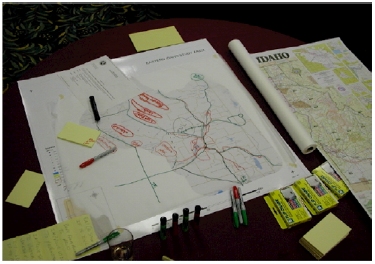 echnology and Workshop Techniques
echnology and Workshop Techniques
Innovative technology and workshop techniques allowed stakeholders to visualize and assess the future impact of different transportation alternatives, as opposed to gravitating toward a pre-conceived answer.
The MetroQuest software showed users the long-term outcomes of different choices by examining a wide range of indicators. MetroQuest allowed participants to consider an array of questions concerning population growth, public and private transportation infrastructure and policies, housing, land use, economic growth, energy, air pollution, solid waste, and water conservation.
As described earlier, MetroQuest provided outputs on over 100 performance measures in a wide range of areas. This included transportation (congestion, safety, VMT, modal split, travel times), land use, air quality, infrastructure costs, taxation, greenhouse gas emissions, ecological preservation, waste, water, energy, housing demographics, and economic growth.
MetroQuest used colorful maps, visualizations, photos, and graphs to illustrate performance measures for future scenarios over the course of four decades (see below). MetroQuest illustrated the integrated nature of issues by connecting choices and outcomes, allowing users to assess a variety of scenarios.
Participants interviewed for this case study commented that technology helped them to collaborate with fellow stakeholders and to understand the implications of alternatives in a highly visual and comprehensible manner. This understanding was critical to the project goal of developing a shared Vision based on stakeholders’ collective input. The technologies represented the commitment ITD made to collaboration early in the visioning process.
The collaborative scenario planning also helped convince the public that ITD and its partners were seeking a different set of outcomes. This occurred because the visioning process was essentially a pre-planning initiative that was designed to feed into planning and to guide project development activities by adding a longer-term and more strategic outlook provided by stakeholders and the public.
The outcome of the visioning process would not have been possible without the public’s collective knowledge, experience, and wisdom. Thus, the most important legacy of the project may be the improved relationship with stakeholders and ITD’s increased ability to make decisions with confidence.
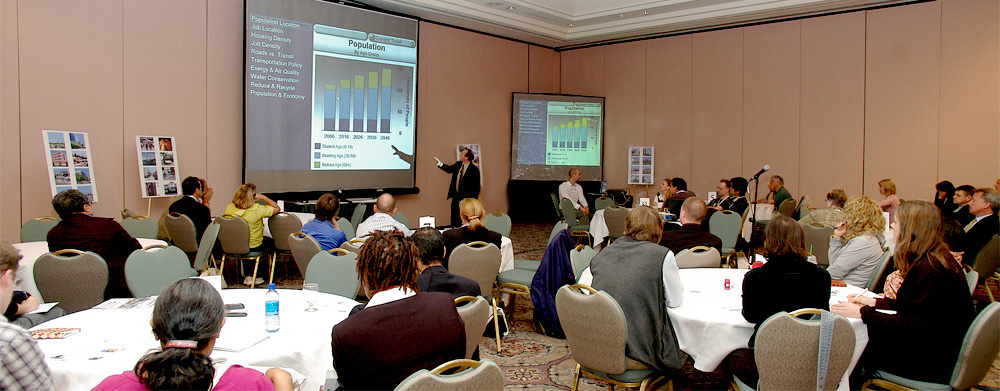
Workshop facilitators walk participants through the results of their scenarios using MetroQuest, using dual screens to illustrate synergies and connections between key performance measures.
Barriers Encountered and Solutions
Pressures to Push Back the Collaborative Process
Idaho’s visioning process consistently emphasized collaboration, despite ITD’s early anxiety regarding the potential for such openness to derail the visioning process. ITD’s commitment to collaboration was ultimately vindicated during the drafting the final Vision document, which required over 40 different draft versions to assure complete accuracy, support, and statewide buy-in.
Changes in Leadership
The departure of the ITD’s director at the beginning of the visioning process was another potential stumbling block. Although this change in leadership did appear to initially slow down the implementation process, it did not result in substantive changes to the Vision. Instead, the Vision document was adapted to support key new context-sensitive solutions that focused on the Vision model of collaboration. These initiatives included an airstrip network action plan and a new strategic plan for identifying focus areas for future planning in the areas of customer service, workforce, partnerships, and performance management.
Trust between Stakeholders and the Lead Agency
Any successful collaborative effort among agencies, stakeholders, and the public hinges on the level of trust among the parties. Before ITD could build and maintain trust with external stakeholders, the Department developed an internal spirit of collaboration within ITD to demonstrate its openness toward engaging with these parties in an open and collaborative design process.
Staffing/Personnel Changes
Changes in staff (internally or with stakeholder agencies) can disrupt the flow of a project and/or the success of its implementation. ITD obtained stakeholder consensus by scheduling periodic review meetings with stakeholders to ensure that they understood the purpose of the various meetings and stakeholder outreach activities.
Stakeholder Participation was Low or too Heavy on the ITD Side in Some Cases
Although the ITD project was able to engage 750 people, most were representatives of agencies. In fact, relatively few members of the general public were engaged in meetings. Moreover, since ITD could require staff to attend sessions, and other agencies and stakeholders attended on a voluntary basis, the result was an unbalanced group of participants at some sessions.
In order to address this challenge, ITD made extensive efforts to ensure that the various agencies involved represented different interests. ITD also created a Vision website and engaged in outreach activities to make sure that the public had access to information throughout the process. These outreach techniques included making personal contacts and invitations, posting notices of meetings in local newspapers, and expressing a willingness to fund travel and per diem to encourage a wide variety of representation.
Challenges with Scenario Planning
Scenario planning tools typically require significant data collection and formatting before use, and often require days or weeks to create and analyze alternatives, making substantive interactivity impossible. To reduce the burden to local agencies and the time required to develop the scenarios, the MetroQuest Scenario Planning software streamlined federal and state data sources to provide 95 percent of data needs for scenario modeling. Moreover, the MetroQuest Scenario Planning software pre-computed possible scenarios so that scenario results could be presented on-the-fly in workshops.
The visioning process recognized the importance of integrating land use, transportation, and environmental planning. ITD configured MetroQuest to explore these synergies by combining models for housing, land use, transportation, demographics, resource management, and economic conditions.
Vision Requires Periodic Revisitation
In light of stakeholders’ changing needs, ITD representatives are planning future reviews of the Vision at five-year increments.
Since the completion of the ITD visioning process, 10 other regions have modeled visioning projects based on elements pioneered in Idaho. The most noteworthy of these may have been the 100-year visioning project for the City of Calgary in Canada, where MetroQuest software was used again.
Implementation as the Next Step
The value of a vision is ultimately measured by the success of its implementation. While the visioning process itself has been viewed as a success by ITD because of the broad stakeholder involvement, the success of the Vision itself will depend on the extent to which decisions are made differently because of the vision.
Although the ITD has indicated that its vision has been used to support a variety of planning efforts, at least one person interviewed questioned whether the vision and its collaborative process has changed the way ITD does business, and to what extent it has influenced project decisions. Thus, the ultimate success of this effort will depend on future actions, and these actions will determine the overall sense of public satisfaction with the outcomes.
In the short term, the ITD has attempted to undertake efforts, such as the development of the Context Sensitive Solutions Guide, with the Vision as a basis.
Summary
ITD’s shared vision document for Idaho’s transportation needs featured innovative technology, early and extensive stakeholder engagement, and a commitment to cultivating and maintaining the collaborative process. Participants interviewed for this case study commented that technology helped them to collaborate with fellow stakeholders and to understand the implications of alternatives in a highly visual and comprehensible manner.
ITD held workshops throughout the process that brought together all of the MPOs and land use decision makers, along with nonprofit organizations and environmental non-governmental organizations.
Moreover, this case study highlighted the critical role of strong agency leadership in cultivating a collaborative spirit both within the lead agency and among separate organizations.
